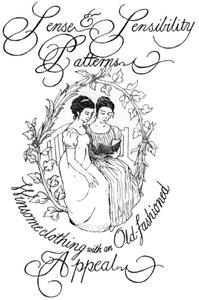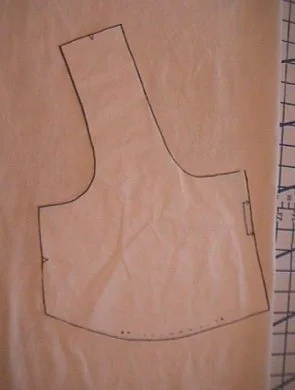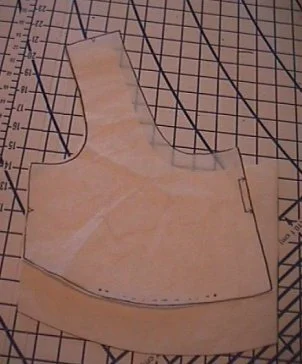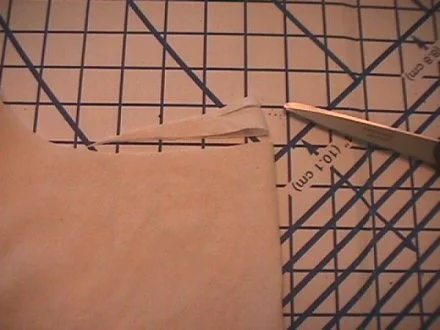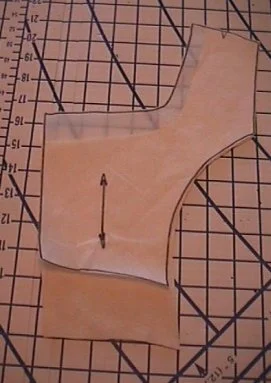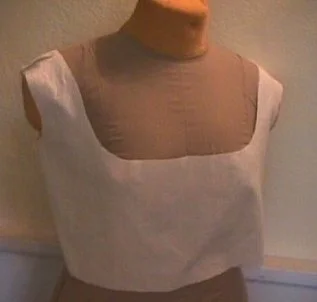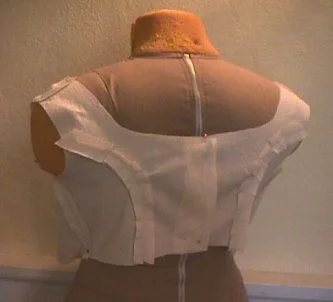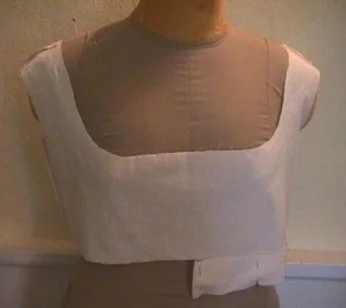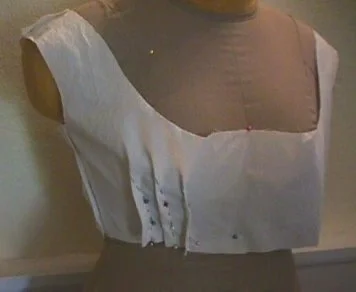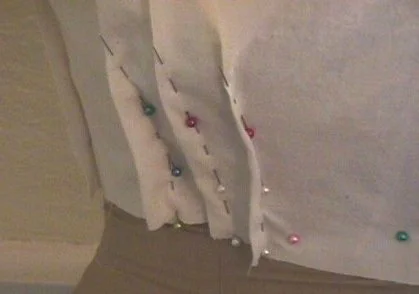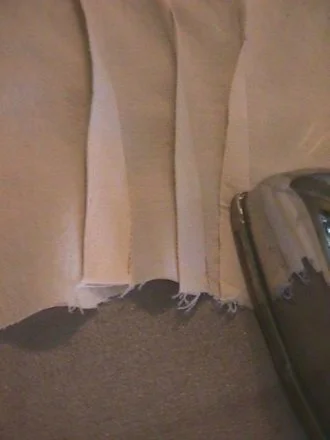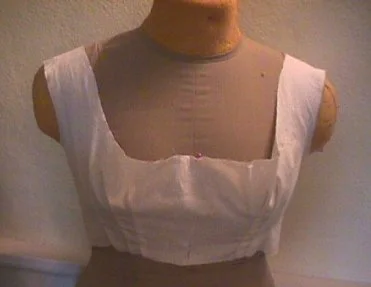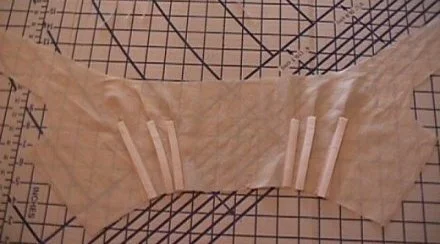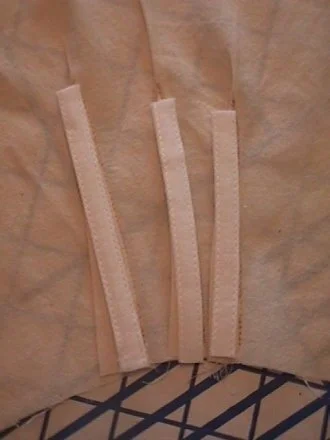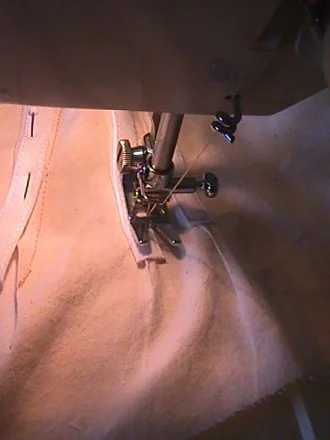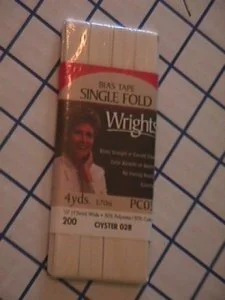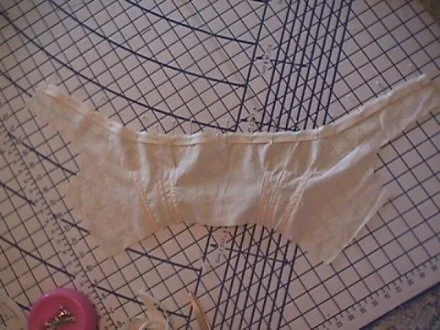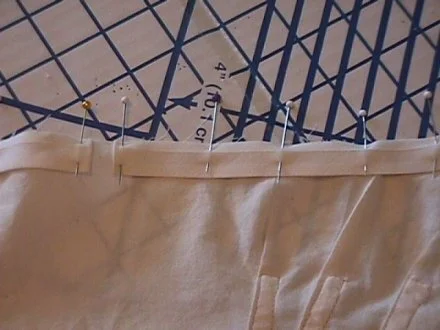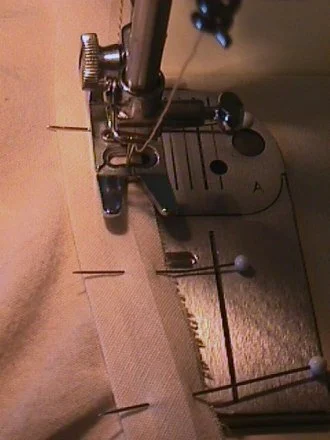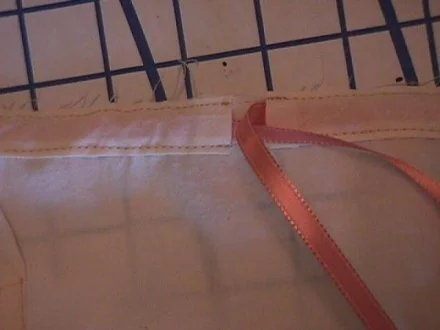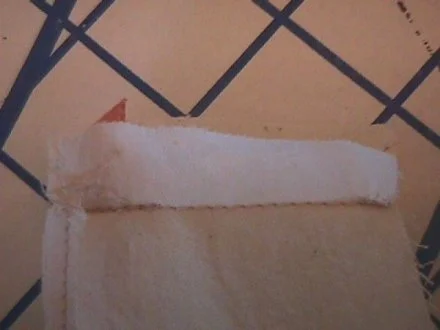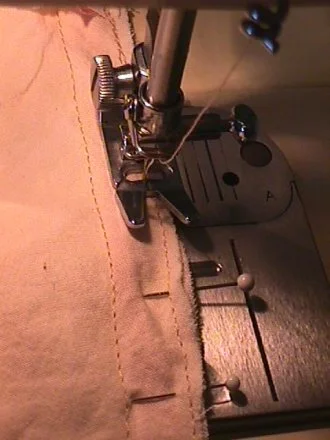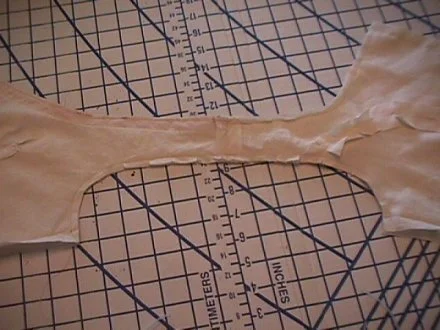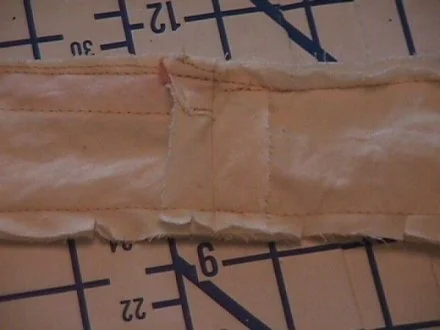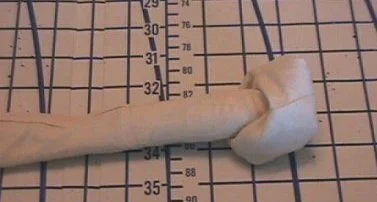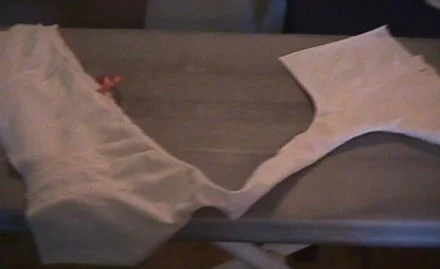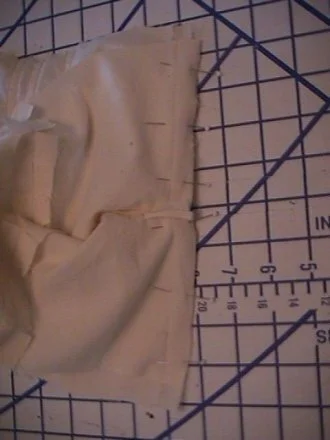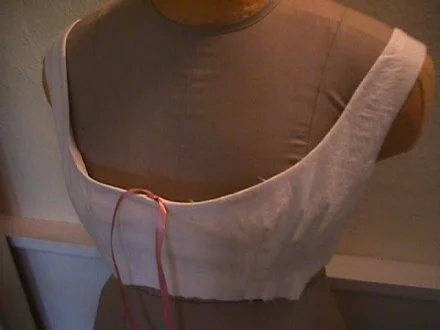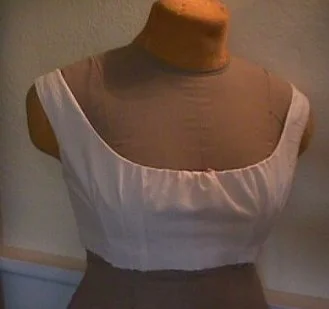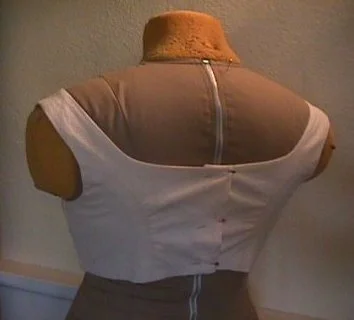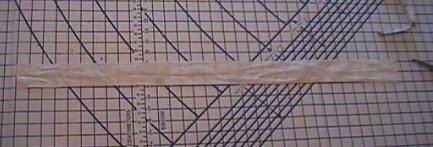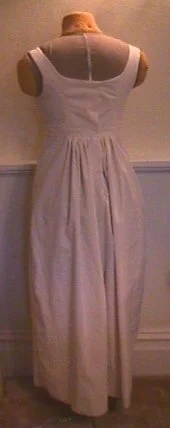How to Make a Bodiced Petticoat from the Regency Gown Pattern
I've received many requests to bring out a pattern for a bodiced petticoat. But if you already have the Regency Gown pattern, you don't need another pattern to make a petticoat; you can just use the gown pattern! [Note: Ladies who are sizes 18-26 D and DD can use the Regency Gown supplement to make the petticoat.] This tutorial is here to walk you through all the steps of taking that pattern and modifying it to make your own Regency bodiced petticoat. Bodiced petticoats were not nearly as common as stays (soft corsets), but I have seen a few. There is a beautifully quilted petticoat bodice (sans skirt) in the Daughters of the American Revolution Museum collection, and there is a small bodiced petticoat (probably for a teenager) in the Valentine Museum. I've heard of others, but I can give details only on the ones I've seen personally. The Regency silhouette isn't something that nature created -- it requires good support to achieve the familiar "shelf" look of the era. I do also have available a pattern for short stays, which appeared in the 1790s and again briefly in the 1820s. They are easy to wear, since they lace up the front, and they work beautifully to create the proper silhouette. If you are over a "D" cup and want the full support, I recommend using RedThreaded’s Regency Stays pattern. But if you're new to the Regency Era and want to get your feet wet, the bodiced petticoat is for you. This will provide you with a supportive undergarment that is easier to make. Do note that you can also use these instructions to create a long petticoat to wear over short or long stays. You would not need the darts or boning in the bodice, but the rest of the instructions (for omitting the sleeves) are the same. Be sure to read the entire section thoroughly before you begin!Before You StartBefore you begin, I recommend that you have the following items at hand:
Swedish interfacing (available at Birch Street Clothing) or heavy-duty tracing paper (available by the roll from architectural supply stores)
Sharpie marker for tracing
3 1/2 yards of muslin (wash it before you begin to pre-shrink)
One package of single-fold bias tape
Two feet of 1/4" boning (see below)
Boning casing (if not included)
Pins
Scissors
Sewing machine
Getting Started: Modifying the Gown Pattern Bodice
Use your Swedish interfacing or tracing paper to trace off the bodice pattern in your size (go by the bustline measurement to determine your size). This will be the master pattern from which you'll work. To cut out the bodice front for the bodiced petticoat, place the master pattern piece on the muslin at a slight angle from the front fold, like this:
The reason you are doing this is to create a bodice front that gapes slightly. You will pull in any extra material with a drawstring, so don't worry about having the front hang open! You need a larger front "neckline," because the petticoat is designed to push up the bosom and flatten it slightly in front. The drawstring will contain any "spillover." Now, before you start cutting, take a look at this picture, which shows where you will be adding to the bodice and where you'll be subtracting:
You are going to cut the neckline/shoulder down about one inch, since you do not want your petticoat to show outside of your dress, and you also are not working to make this undergarment modest by any stretch of the imagination. This is not a garment in which you will go walking down the street! It is meant strictly for wearing under a Regency gown. If you want to be even more correct, I recommend making a shift (chemise) first (which is what is usually worn under stays or a bodiced petticoat). You can use my chemise pattern to make this first layer. If you do decide to wear a shift in addition to your petticoat, you'll need to make the shift first, since you'll have to do all of your subsequent petticoat fittings over the shift.But to get back to the petticoat.... Besides cutting the neckline/shoulder area down, you need to add about two and a half inches to the bottom of the bodice. You will later end up cutting some of this away, but you want to start out with plenty of material to "play" with while you are fitting the petticoat to contain your bustline properly. After you've cut out the front as shown here, you'll need to trim away the "peak" at the center front to make the front "neckline" even all the way across. What you trim away will look like this:
Now you're ready to cut out the back and side back. Remember that you need to add as much to these pieces and subtract as much as you did on the bodice front. You also want to make sure that the front and back shoulder straps are exactly the same width. Just use your bodice front piece as a guide when you cut out the bodice back:
Cutting out the back.
Matching shoulder straps.
Cutting out the side back.
Fitting the Bodice Toile
With all the pieces cut out, you're ready to baste them together to create the toile you'll use to fit the petticoat to yourself. Remember: do not stitch your pieces together with a short stitch! You want to be able to pull out the stitches after you've perfected the toile so that you can use them to cut out your lining pieces (and make a master petticoat pattern on tracing paper if you wish). Once you baste the pieces together, you have a bodice that looks like this:
[Note: All of the fitting steps below are demonstrated on a foam mannequin. Foam doesn't behave quite like human flesh, so what you see here won't be precisely what you get when you create your own petticoat to fit yourself. Just keep that in mind as you review the steps. The mannequin doesn't end up with a "shelf" silhouette at all -- she's much too stiff. When you make your own petticoat, you will be able to use the pictures here as a guide. Don't take them as an inflexible map to success, however! Your own human form is going to look a lot different than this foam mannequin! ;-)]With the toile on the mannequin (or on yourself), you'll be able to see how much of the bodice you need to trim away. You need enough material to completely cover the bustline (below the empire waist) and leave enough for a 5/8" seam allowance at the waistline. If the bodice is too short, you will not have enough room for the boning that is going to support your bustline. But it doesn't need to be extremely long, either. I'd aim to have it at least one and a half inches longer than the empire waistline of your Regency gown. Here is a picture of what I trimmed away on the mannequin's petticoat:
Trim the back to match the front, and you are ready to start pinning darts! You'll need a helper for this next step. I recommend a very close female family member or husband, since the fitting is basically like going to try on brasseires! Have your helper pin the back of the bodice closed so that the top edge overlaps the bottom about two inches. This should make for a snug fit, though you'll still have loose material at the "neckline" and bottom edge of the bodice front. Now it's time to pin your darts that will push the bustline up and in. I recommend a minimum of three darts. The middle one is centered on the bust point, and the outer two are about an inch away on either side. The darts are not meant to behave like conventional darts (which basically come to just under the bust point). Instead, they are intended to go over the bust point to force the bosom inward and upward. As a result, they need to be quite snug. Once you have them pinned properly, they'll look something like this:
The top portion of the dart is curved slightly; it isn't an inverted "V," in other words. Go ahead and baste the darts in place once you have them pinned, then press them toward the side of the bodice, like this:
You can see the slight curve on the far left dart.
Try on this basted bodice and check to make sure the darts are placed properly and are doing what they are supposed to do (support and lift). Keep in mind at this point that you'll be adding boning to the front darts, which will help support you. Right now you are just checking for proper dart placement. Here's what my final bodice toile looked like:
Making the Final Bodice
You can remove the basting stitches from your toile now and take it apart to use as your pattern to cut out your lining. Mark your darts on the lining with pins or a washable fabric pen and copy the markings onto your bodice front as well. If you plan to make more than one petticoat, be sure you trace the final pieces for your master pattern and mark the darts. Cut out your lining pieces and your outer pieces, then set aside the outer pieces for now. [Note: if you prefer, you can use a heavier material, like cotton duck, for the bodice lining. This offers more support, since it is stiffer.]
Time to bone those front darts!
I used to recommend spiral boning, but that was back when better alternatives for this time period were all but impossible to find. I now prefer to use reed, as I can cut it to the exact length needed and file the ends smooth. Reed is available in the basket-making or woodcrafts section at Hobby Lobby and Michael’s. I use the quarter-inch width, which fits perfectly into the channels. Another amazing option is synthetic whalebone, which has the correct thickness and shaping ability as the actual whalebone used in the time period. Whatever you choose to use, if your boning comes already in its own casing (like plastic boning does), then you can use the casings as-is. If not, you can create your own casings from bias tape. In this example, I've used plastic boning with its own casing. Here is a picture of the casings cut to match the length of the darts and placed next to the stitching line of each dart:
You are going to pin the casings to the wrong side of the bodice front. Here's a close-up so you can see the exact placement of the casings:
Using the stitching lines that are already on the casings, stich up one side of the casing from the bottom edge of the bodice, across the top of the casing and down the other side, as shown below:
Repeat for all of the casings. Here is a picture of the bodice lining with all the casings sewn in:
Now cut your plastic boning to fit the casings, making sure they are 5/8" shorter than the casings, since you need to leave room for your waistline seam allowance. To keep the ends of the plastic boning (if that's what you're using) from poking you, trim off the corners so you have a smooth, rounded top and bottom. Here is a picture of the other side of the bodice once the casings have been sewn in place and the boning inserted:
This stitched side is what will be facing your body when you finish the petticoat. Consider it the "right" side of the bodice lining.Now you need to add the drawstring casing and the drawstring to the inside (the right side that will be against your body) of the bodice lining. I use single-fold bias tape for my drawstring casing:
You need to iron out one edge of the bias tape (removing the fold along one side). This side will be the one that matches the top neckline edge of your bodice. Cut the drawstring casing long enough to reach from one shoulder to just past the center front of the bodice. Pin the casing to the bodice from the shoulder to the center front of the bodice, turning under the extra amount at the center front. Repeat for the other side, and your casing will look like this:
Here is a close-up so you can see that the unfolded edge of the bias tape is right up against the edge of the bodice "neckline":
Sew the casing to the bodice, stitching a scant 1/8" away from the top edge of the bodice front:
Now sew the bottom edge of the casing to the bodice, stitching as close to the edge of the casing as possible. Once that is finished, you are ready to run drawstring or ribbon through the casing. Cut two lengths of drawstring long enough to run through the casing and leave enough to tie. I used ribbon on my model petticoat, as you can see here:
Okay! Now you're ready to put your bodice together! Sew the lining side backs to the backs, then sew the lining front to the back at the shoulders, catching the ribbon (or drawstring) in that seam to hold it, like this:
Repeat this for the outer bodice (sewing side backs to backs and sewing shoulders together). At this point, you are not going to sew up the side seams. Instead, you will pin the bodice to the lining, right sides together, and stitch all the way around the neckline (up one back edge, around, and down the other back edge). To begin, take up a 5/8" seam at the center back edge. When you reach the "neckline," just stich a scant 1/8" away from the top edge. When you get to the bodice front, you'll be stitching right on top of the stitches you made when you sewed the drawstring casing on, like this:
Do take care to make sure you don't catch any of your drawstring when you are stitching around the front of the neckline! Continue on around to the opposite back edge and take up a 5/8" seam there to finish. Now you are going to stitch the armholes on either side, taking up a 3/8" seam. Clip the curves, and you'll get what you see here:
Armhole sewn.
Close-up of shoulder strap.
To turn the bodice right side out, you will need to "feed" each side of the bodice back through the shoulder strap and out the front. While you are turning the bodice, it will look something like this:
Once the bodice is turned, it'll look like this:
Now you can sew the side seams together to finish up the bodice! To do this, open out the sides of the bodice and match the center (underarm) seam of each side seam, like this:
Stitch, using a 5/8" seam. Press neatly, and you have a side seam that looks like this:
Voila'! A nice, neatly enclosed shoulder strap! Make a note of this technique for all your future sleeveless projects (jumpers, vests, etc.). It works so nicely!Time for a quick try-on to double-check your fit:
Bodice with drawstring untied.
Bodice with drawstring tied.
Bodice back.
Making the Waistband and Skirt
You are more than halfway to having your petticoat finished, and the hardest work is behind you! Now it is time to make the waistband for the petticoat. Measure around the bottom of the finished bodice, then add 1 1/4" so that you'll have 5/8" to fold under at either end. Cut out a waistband and a waistband lining out of your muslin:
Pin the waistband to the bodice, folding under 5/8" at each center back edge. Stitch to the bodice. Set aside. Now cut out your skirt front and back, using the Regency Gown pattern's skirt pieces. [Note: If you plan to wear the petticoat under a Regency gown with a lined skirt, you will need to make the petticoat skirt as narrow as your gown's skirt lining. However, I really don't recommend lining a gown if you plan to wear a petticoat beneath. Or, if you do line the gown skirt, be sure you make the lining as wide as the skirt back so that your petticoat doesn't bunch underneath a narrower skirt back lining.]Follow the instructions in the Regency Gown pattern to sew the skirt pieces together and add a placket at the center back. Now pin the skirt to the waistband of the petticoat, matching the center back edges to the center back placket on the petticoat skirt. Stitch, taking up a 5/8" seam. Try on the petticoat to check the hemlength. You want the petticoat to be at least half an inch shorter than your gown will be so that it doesn't show.
Finishing the Petticoat
All you have left to do now is line the waistband, hem the petticoat and close up the center back! Follow the steps in my online 1914 Pattern Instructions to line the waistband of the petticoat.To close up the back of the petticoat, you can use hooks and eyes (I recommend skirt hooks with bars, since they are sturdier), buttons and buttonholes or corset lacing. If you use the latter, you'll want to make the center back opening so that it doesn't overlap. (See why I tell you to read this whole page before you start?) Once you have the back opening finished, try on the petticoat to do a final check, then have a helper mark the hemline for you. Hem it up, and your petticoat is finished!
Variations on the Theme
To make your petticoat's skirt stand out just a wee bit (not uncommon in the late Regency), you can cord the hemline or add horsehair inside a deep hemline. You can also cut your skirt pieces long enough to accommodate two to six tucks, which you can also cord or reenforce with horsehair. This won't make your petticoat into anything close to a hoopskirt, but it does help your gown skirt drape very nicely around you.If you want to get fancy, you can make a bodiced petticoat out of a colored silk, satin or even cotton and wear it beneath a sheer (unlined) Regency gown. This was actually quite common in the Regency period, and you see this in portraits of the time. The colored underdress would be cut higher in the front and back for modesty's sake, of course, and with the overdress of voile, organdy or lawn, it would make a most striking ensemble.Whatever you decide to do, have fun! This method isn't nearly as hard as it might look at first glance. When you're working on your toile, just remember, it's only muslin! You are most definitely allowed to make mistakes and start over again. That's what a toile is for. Just keep the end goal in mind (a nicely fitted petticoat), and you will get there with a bit of work and determination!
